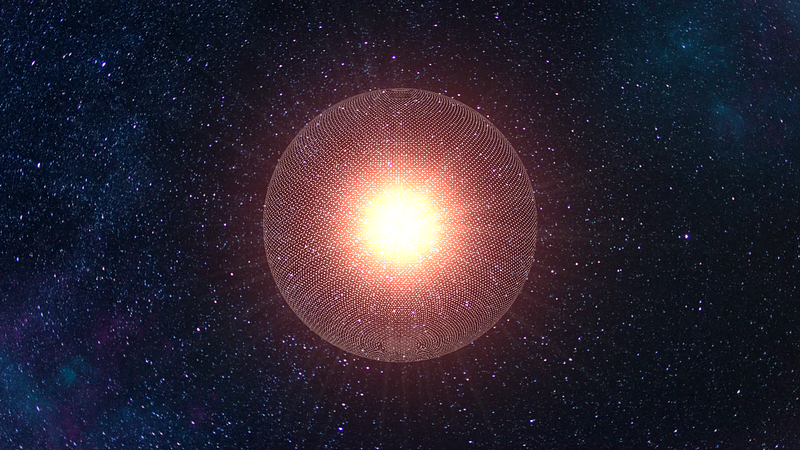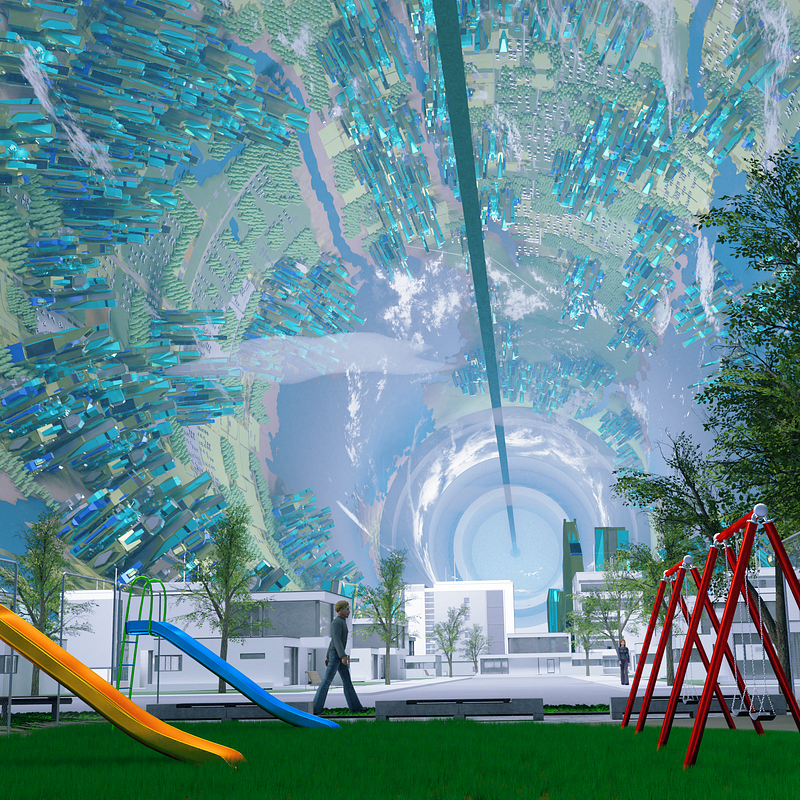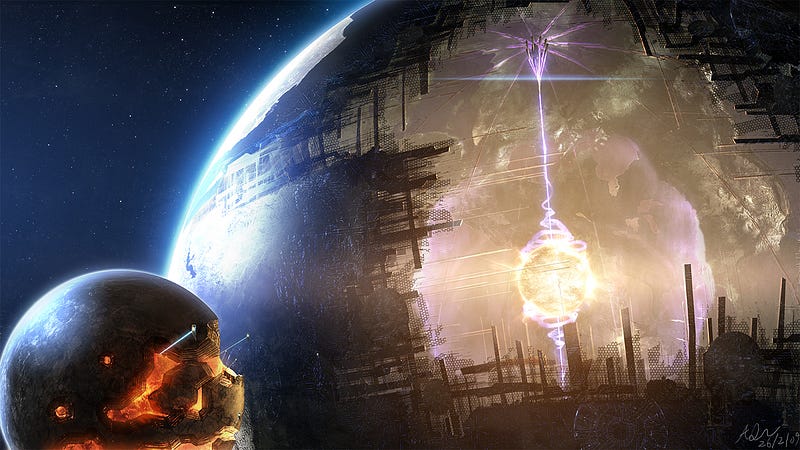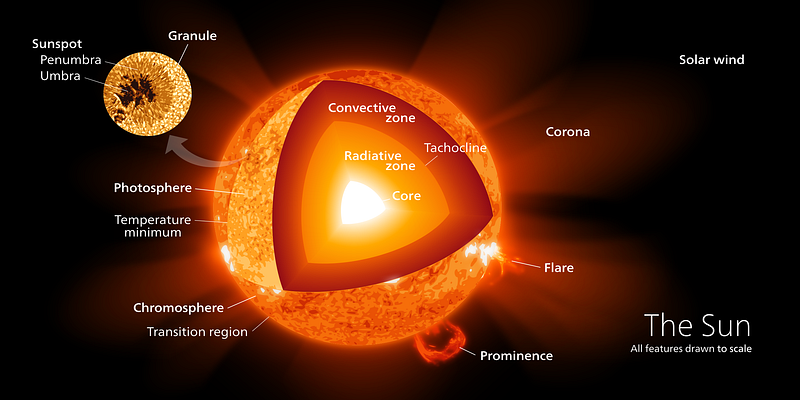Envisioning a Dyson Swarm: A Realistic Future in Space
Written on
The Concept of a Dyson Swarm
Imagine how a modern airplane or skyscraper would appear to a Neanderthal, who had yet to discover even the wheel. In the 1960s, Sir Arthur Clarke remarked in Profiles of the Future, “Any sufficiently advanced technology is indistinguishable from magic.” This notion inspired the term "Clarketech," referring to technology so advanced that it seems almost magical, enabling civilizations to achieve extraordinary feats beyond our current understanding.
When discussing a Dyson swarm, the idea of Clarketech often surfaces. However, this network of space habitats offers all the benefits of a Dyson sphere and is well within humanity's reach. Instead of creating a massive shell capable of surrounding our Sun, we could construct individual, island-sized rotating habitats. Over millennia, these colonies could collectively capture the entire energy output of the Sun, potentially accommodating billions of people in comfortable, upper-middle-class living standards.
New advancements in technology and materials that can be developed in zero gravity, along with easy access to the vacuum of space, will allow for the creation of habitats as large as continents, capable of supporting billions.
Colonizing the Final Frontier
The evolution of multicellular life over the past six hundred million years has made our bodies reliant on Earth's gravitational force. A space colony would be a rotating cylindrical megastructure designed to simulate 1g gravity. Within these self-sustaining ecosystems, air and water would be fully recycled, while solar panels in space could generate significantly more electricity than those on Earth's surface, meeting the energy needs of millions of inhabitants.

As depicted in my novel K3+, “That’s the food production area; it’s how we feed the millions living in this colony. By growing our food far away from populated areas — in the microgravity zone — we can maximize the use of the drum for human habitation. Production is fully automated and runs 24/7.”
However, constructing even one of these colonies will take centuries without a substantial space-bound infrastructure. The initial framework for construction and manufacturing will require decades and thousands of rocket launches to transport specialized components, which will be produced on Earth for many years until space-based factories become a reality.
The resources available in the inner solar system are virtually limitless, although challenging to access. Just as one starts with small steps when building a campfire, we could begin by mining the Moon and nearby asteroids. As our human presence in space grows, we will gain access to larger reserves of raw materials, such as those found on Mercury.
Once the first space colony is established, advancements will accelerate. The technologies and materials developed in zero gravity will facilitate the construction of expansive habitats that can accommodate billions of inhabitants.
Reaching Beyond Our Solar System
The Milky Way boasts around 200 billion stars. By utilizing powerful lasers in space, we could propel colony ships to a significant fraction of the speed of light, allowing us to reach neighboring stars within a few decades.

A captivating aspect of science fiction, as illustrated in Larry Niven’s Ringworld, involves the engineers who dismantled planets to create a gigantic ring around their star. Yet, the raw materials required for constructing a Dyson megastructure would not derive from disassembling planetary bodies. Such an endeavor relies on Clarketech, and the loss of a planet's mass would displace it into a more distant orbit. Fortunately, a more viable solution exists: mining the Sun.
Our star generates energy equivalent to humanity’s annual consumption every 500,000 seconds and contains vast amounts of raw materials that we can utilize. These materials exist as individual atoms swirling around the corona, which we can capture and assemble into usable forms for construction—similar to how we extract gold on Earth.
But is this also Clarketech? The answer is a definitive no. The energy for this immense operation will be sourced from the Sun itself. No process is too inefficient when there is a virtually unlimited power supply available to drive it. Star lifting is a concept that capitalizes on this principle, extracting raw materials from the Sun's high-energy convective zone.

The infrastructure required for this endeavor will necessitate centuries to build. Mercury presents an ideal target due to its composition (70% metals, 30% silicates) and its proximity to the Sun. Its low gravity allows a Mass Driver to launch components into the Sun’s orbit and transport mineral ores to Earth's orbit for the construction of our first space colonies.
As noted in my novel K3+, “True that reaching Mercury is very hard…from Earth. But in space, we don’t need all that fuel to break off our planet’s gravity well! From Terminus, the amount of propellant to reach Mercury and land is minuscule in comparison. Besides, Mercury is the leftover rocky core of a past collision that stripped the planet’s mantle away, which means we won’t have to dig very deep to reach the ores we need.”
After centuries of establishing space colonies, the resources around the Sun will eventually become exhausted. However, with 200 billion stars in the Milky Way, we can use giant lasers to propel colony ships towards neighboring stars, making interstellar travel a reality.
A New Perspective on Human Expansion
Earth serves as humanity's cradle, but transitioning to a spacefaring civilization will sever this umbilical connection. This is why other planetary bodies cannot become our permanent homes. Our inherent bias towards our home planet limits our perspective. The Earth has a finite capacity, and the lower gravity of Mars could pose significant challenges for sustainable living. Rotating habitats orbiting the Sun could support quadrillions of inhabitants in ideal conditions, allowing for luxurious lifestyles.

In the 1970s, American physicist Gerard O'Neill demonstrated that we have the ability to construct such structures. He likened it to building a house on a mountain: rather than transporting materials from the ground up, we can utilize resources found directly on the mountain—commonly referred to as in-situ resources.
While we may not yet be able to construct an O’Neill cylinder, we can establish a smaller colony capable of supporting approximately 1,000 people within a few decades. This initial settlement will serve as the first human outpost in space, allowing us to conduct research and develop the capabilities necessary to manufacture large colonies for millions.
In K3+, I state, “...we’ve reduced the time it takes to build an O’Neill cylinder to ten years. And, although the trend will continue, growing demand has finally caught up. I’m afraid the era of pioneers is over; we now face a waiting period of weeks that will continue to increase as more people want to come to space.”
Building a Dyson swarm will span a millennium. This endeavor will require a shift in economic thinking towards long-term planning rather than immediate gratification. However, it is essential because Earth cannot sustain the exponential growth of our civilization indefinitely. Even if we reduce consumption, shrink our economies, stabilize our population, and decarbonize the atmosphere, we will only delay the inevitable.
O'Neill once posed a thought-provoking question to his students at Princeton University: “Is a planetary surface the right place for an expanding technological civilization?” Their responses led him to design the first rotating colonies. Earth is humanity’s cradle; our future lies in floating oases among the stars.
The Future Awaits
My dystopian novel K3+ explores civilization's collapse due to climate change and economic inequality, followed by humanity's rise to an intergalactic empire. It serves as a roadmap for navigating our current challenges, colonizing space, and preserving our planet. The blend of groundbreaking science and captivating fiction illustrates our potential future.
A Roadmap to the Future
An excerpt from K3+
This video discusses the possibilities and challenges of constructing a Dyson sphere, highlighting the technological advancements that may make it feasible in the future.
In this video, the host explores what it would take to build a Dyson sphere, addressing the engineering and resource management required for such an ambitious project.